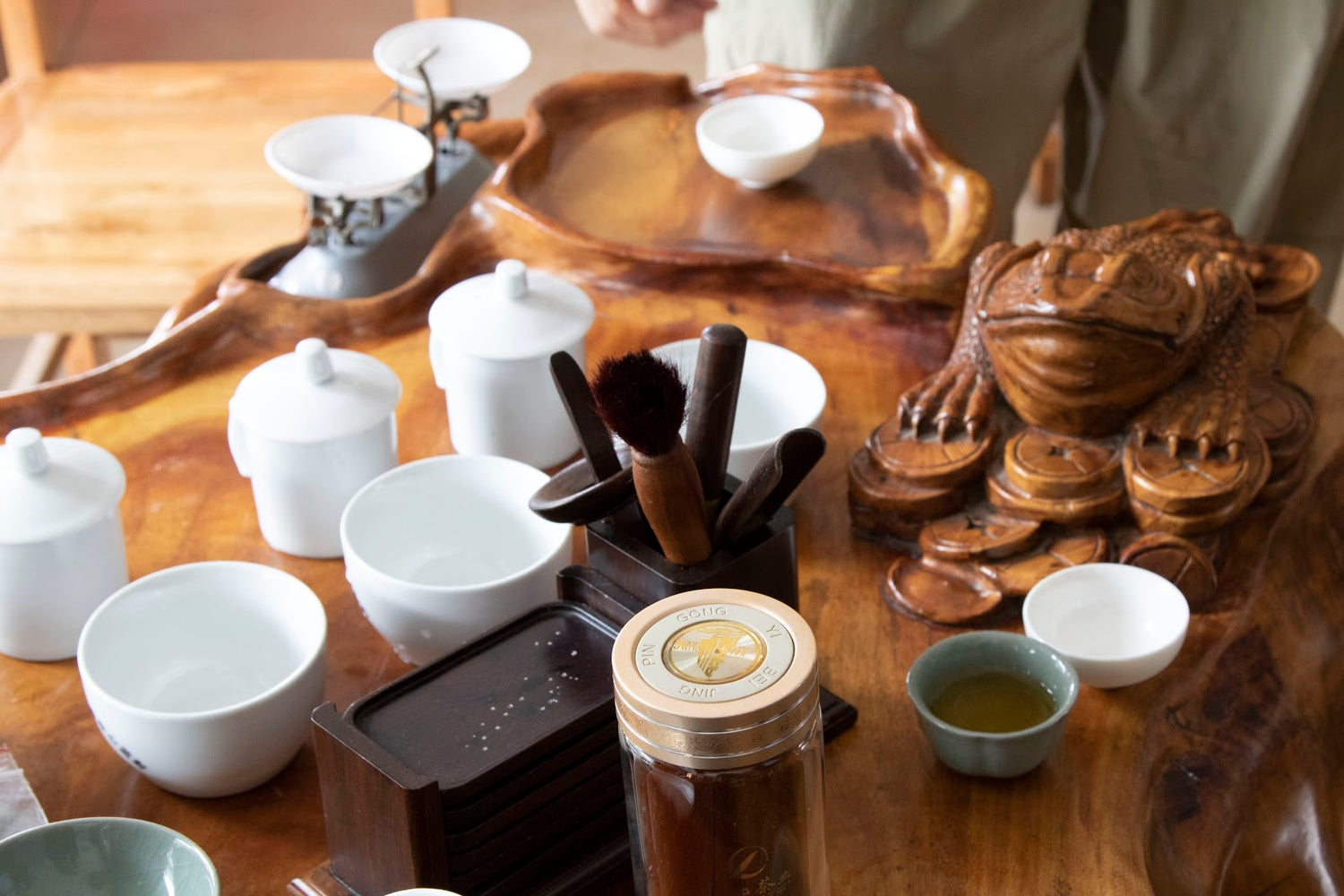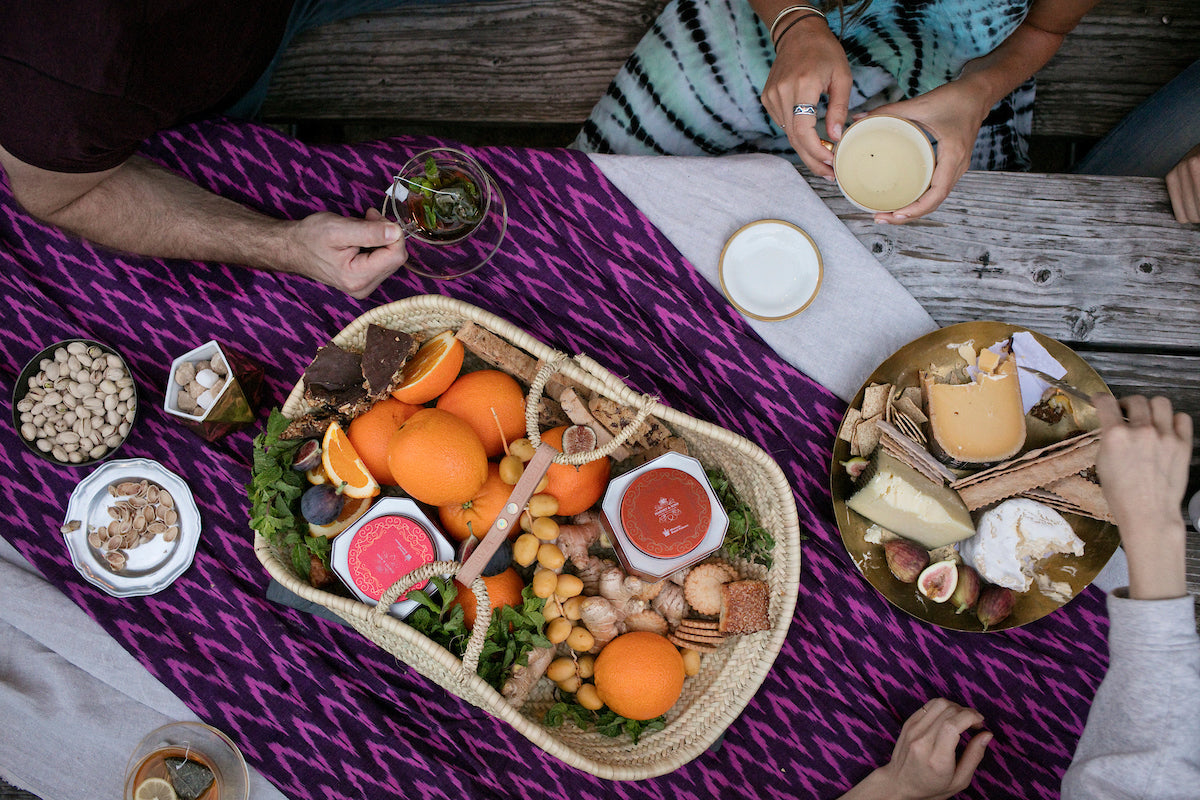Where do we start with Chinese tea traditions? Since China is where tea got its big break, the reverence for tea and its incorporation into daily life are ubiquitous among the Chinese. If every one of their fortune cookies said, “Tomorrow you will have tea” they would almost certainly be right 100% of the time.
Totally woven into the fabric of life, tea was regarded in ancient China as one of the seven most important elements in Chinese life (the others being firewood, rice, oil, salt, soy sauce, and vinegar, which is like modern Americans saying tea is like gas, electricity, internet, cell service, pizza, Netflix, and Amazon).
While we have delved into tea traditions in Japan and Britain, the Chinese have ceremonies and meanings all their own. While there are similarities, China holds a very special place in the world of tea.
If It Falls in Your Cup, Drink It
While the stories and legends about the origins of tea are as varied as Lady Gaga’s wigs, one story that is consistently told is of a Chinese emperor who, around 2700 BC, was purifying water under a tea tree when some leaves landed in the pot. The emperor, who was either intensely curious or somewhat farsighted, drank the leaf-infused water and pronounced it right on! It wasn’t long before tea started experiencing widespread popularity.
While it was first appreciated primarily for medicinal purposes, enjoying tea for how it tasted wasn’t far behind. Starting in the 9th century, tea made its move on Japan, Korea and the Middle East. For centuries, China owned the tea-exporting business, and while countries like India and Ceylon have certainly taken a lion’s share of the market, China remains one of the largest suppliers of quality teas.
Far from exporting it all, however, they certainly keep a fair amount for their own citizens, who cherish their tea rituals and view it as far more than a beverage.

You Can Show Respect
Chinese heritage and tradition are steeped in respect. From the household to the board room, even today there are protocols that are not to be broken, and one of those is offering tea to your elders or superiors.
Traditionally, younger generations of Chinese show respect to an older generation by offering or taking them out for tea. The same is true in the workplace, where again traditionally employees would offer tea to their superiors, not vice versa. In today’s more liberal Chinese society, these long-held practices are not as strictly observed, except in formal occasions where they are scrupulously adhered to.
You Can Apologize
In China, you can seriously offer up a cup of sorry. If you have offended or wronged someone, criticized their ancestors or said they have big dumplings and you cannot lie, you can make amends by pouring them a cup of tea. When done sincerely, this is taken as an act of regret and humble apology. We really don’t think coffee can do that.
You Can Do the Secret Tea Handshake
Well, it’s not really a handshake, but it’s pretty cool. Here’s the story.
Back in the mid-1700s, the Qianlong Emperor, in a beta version of “Undercover Boss,” wanted to know how things were in his kingdom. So he dressed as a regular guy, took a servant and went out to see what was what.
While they were checking out his peeps, the Emperor and his servant stopped for tea… and the Emperor poured tea for his servant, breaking all kinds of tea protocol. The servant, understandably touched and probably somewhat confused, wanted to show his gratitude in the traditional way by kneeling before the Emperor. But wait! By doing so, the servant would reveal all and the Emperor would immediately be recognized as Qianlong!
Instead of blowing the Emperor’s cover, the servant quickly came up with an alternative: he bent two fingers and tapped them against the table, subtly conveying his thanks and respect. It worked great until Qianlong whipped out his Chinese Express card to pay and the gig was up.
To this day, tapping two fingers on the table when someone pours you a cup of tea in China is recognized as “thank you.” We are fans.
Gongfu or Go Home
While there are other Chinese tea ceremonies, the Gongfu tea ceremony dates back hundreds of years and is the most well-known. “Gongfu” means the art of doing something well, so this ceremony represents that philosophy—you are expected to invest the time, effort and care to create a true art-like tea experience. Whether you spell it “gongfu,” “kung fu,” “kung fu-cha” or “gong fu-cha,” the expectation is that of a perfect or near-perfect ceremony.
The style of Gongfu is something that can seem so understated and yet entirely change how you enjoy tea. My first exposure to Gongfu was on my first trip to China with my father, Mike. There’s a reverence for all aspects of tea to enjoy in Gongfu: the smell, the sight of the leaves, the layers of taste as each brew finishes. Last and certainly not least, there’s the social aspect to this way of enjoying tea. While engaging with your host or fellow tea drinkers, a bond is created over this unique moment in time you’ve created through this everyday ceremony.
What do you need to create a Gongfu tea ceremony? For starters, a peaceful, calm setting which includes your state of mind. No feeling hurried, rushed, or stressed. That is most definitely not the Gongfu way.
Next, select your tea. A traditional Gongfu tea uses an oolong tea, sometimes a pu-erh, but rarely a green tea. See the section below to learn more about Chinese teas.
You can select the finest tea in the world (always found at Harneys!), but if your water is substandard you’ve just sabotaged the whole process. Use only the purest, cleanest water. Not only will your taste buds and your guests thank you, but in a nod to the spiritual nature of the Chinese, you’ll be paying homage to nature and the Earth’s elements as well.

Next up: Gongfu tea ceremony essential tools:
- A teapot, preferably a Yixing teapot if you can get one. Made from Yixing clay, this is the traditional-style teapot used to brew tea in China dating back to the 15th century. You can also use a porcelain teapot or a gaiwan, which is a Chinese lidded bowl, lid and saucer used to infuse tea and water.
- A tea pitcher or chahai to ensure the consistency of the tea’s flavor.
- A brewing tray is part of the Gongfu experience. In a more casual ceremony, you can use any flat-bottomed plate or tray that will hold spills.
- A tea towel or cloth. They are usually dark in color, and you really kinda need one.
- A teaspoon or tea pick to clear the teapot spout and clear tea leaves.
- Tea cups
- Snifter cups
- Tea timer
- Tea strainer
Once your tools are in place, you’re ready to begin. It may seem like a lot, but it’s really very simple. Just remember: breathe in, breathe out, tea on!
Warm your teapot and cups by pouring boiling water in them. This is an important step so don’t skip! Discard the water after a few minutes.
Next, you would traditionally pass around the tea leaves (never a tea bag or sachet for a Chinese tea ceremony) for your guests to appreciate the aroma and quality.

Now, for the most important part: make the tea! Done correctly, you’ll get some water in your tea tray during a Chinese Gongfu tea ceremony.
- First, preheat each of the vessels. No one likes a cold cup!
- Add the leaves to your teapot. Return the lid, allowing the warmed cup steam the leaves. The heat will help to release fabulous aromas. Feel free to take a peak in and smell these newly apparent aromas. Then, raise your teapot to shoulder height and pour in boiling water until the water spills out slightly. Scoop away the bubbles and tea leaves and put the lid on the teapot.
- Next, pour all the tea into the tea pitcher, then from the pitcher into the snifter cups. Cover the snifter cups with an empty teacup, then invert them so the tea flows into the teacup. Lift the snifter cup and enjoy the aroma of the tea.
- To drink the tea, cradle the cup with both hands – use the thumb and index finger to lift the cup while the middle finger holds the bottom. This is called “Three Dragons Guarding the Ding (an ancient cooking vessel).” Take three sips of the tea. Savor the tea’s flavor.
- Additional rounds of tea can be made until all the flavor is extracted from the tea leaves. Oolong tea leaves can be reused up to five times.
An optional but fun part of a Gongfu tea ceremony is the tea pet! Tea pets are small clay figures that many tea drinkers have for good luck. They are usually made of Yixing clay and, like the Yixing teapots, they are unglazed. Chinese tea lovers “raise” their tea pet by placing it on the tray during the ceremony and pouring tea over it. Over time, this will change the color of the tea pet, which means it is well loved!
While tea pets can come in the form of zodiac animals or Chinese mythical creatures, the most popular is the “pee-pee boy” whose job it is to indicate if the water is hot enough to make tea. (We are not making this up.) After soaking the pee-pee boy in cold water, hot water is poured over him. If it is the proper temperature (science is involved), the pee-pee boy will do as his name indicates—entertainment and proper water temperature all rolled into one!

Other Chinese Tea Ceremonies
In addition to Gongfu, there are many other types of tea rituals in China, including:
- Wu Wo Tea Ceremony. “Wu wo” is a Buddhist concept which means “without self.” In this ceremony, everyone brings their own tea sets, and social rank has no meaning.
- Perennial Tea Ceremony. Also known as the Four Season Tea Ceremony, it stresses eternal continuity, perfect harmony and respect and love for nature. The four participants represent each season; together with the leader, they represent the five Chinese traditional elements and colors.
- Wedding Tea Ceremony. During this important traditional ritual, both the bride and groom serve tea in a gaiwan to both sides of the parents, recognizing the moment where members of each family become relatives. It is an important show of respect and honor.
Selecting the Right Tea
Fortunately, the Chinese have made it easy to select the proper tea for your ceremony or, for life’s non-ceremonial occasions, just a delicious tea to enjoy during your day.
Chinese Green Teas. If you want to enjoy a traditional Chinese green tea, you can’t go wrong with Jasmine, a fragrant floral tea, Chun Mee, a traditional green summer tea or Lung Ching, a favorite worldwide.
Chinese Black Teas. Where to start? Our Chinese black teas bear no similarity to that bag of tea from the grocery store you grew up drinking. Blended from the finest tea leaves to produce mellow-not-bitter teas that range in flavor and intensity, you’ll find a tea you can’t live without. Try Pu-erh if you’d like to have a traditional black tea in your Gongfu tea ceremony, or just because you want to.
Chinese Oolong Teas. If you want to host a Gongfu tea ceremony like a boss, oolong is your traditional go-to. We have nearly 20 Chinese oolong teas for you to choose from, but if you’re looking for tried and true, you can’t go wrong with Ti Quan Yin. The rolled-style oolongs slowly unfurl with each infusion, yielding a story of flavor.
Matcha Teas. For a truly Asian experience, this ancient tea is a one-of-a-kind drink. Love it or leave it, you’ll never know until you try!
The great Chinese philosopher Confucius said this: “Never give a sword to a man who can’t dance.” Just like all the complexities that go into Chinese tea traditions, we may not understand fully what it means, but we like it! Enjoy this wonderful, ancient world of tea.
















4 comments
N.
The great Chinese philosopher Confucius said this: “Never give a sword to a man who can’t dance.” A great quote!
The great Chinese philosopher Confucius said this: “Never give a sword to a man who can’t dance.” A great quote!
Sheila Wright
That was a great tea blog! I have never heard any Chinese tea lore so all that info was new and interesting to me! Never stop learning! Thanks for sharing that!!
That was a great tea blog! I have never heard any Chinese tea lore so all that info was new and interesting to me! Never stop learning! Thanks for sharing that!!
Zachary Brass
I am pretty versed in at least the basics of different cultures, but this whole article flipped the script for me because I had no idea about Chinese tea traditions and this helped me learn a lot about China and how they think and act. I truly enjoyed learning about the Chinese traditions that you explored here and I will be trying some of the teas mentioned!
I am pretty versed in at least the basics of different cultures, but this whole article flipped the script for me because I had no idea about Chinese tea traditions and this helped me learn a lot about China and how they think and act. I truly enjoyed learning about the Chinese traditions that you explored here and I will be trying some of the teas mentioned!
david sabin
I’m one of the thousands of Harneyites out there, and have read Michael’s book many times. These mini-lectures are a wonderful and deep way of taking tea into our souls as more than the usual shallow sense. Bravo and keep them coming. Personally, I got the word that this is out there from my Yahoo email, so that’s where it’ll be easiest to get me……….and is a reason to check the location more often!
I’m one of the thousands of Harneyites out there, and have read Michael’s book many times. These mini-lectures are a wonderful and deep way of taking tea into our souls as more than the usual shallow sense. Bravo and keep them coming. Personally, I got the word that this is out there from my Yahoo email, so that’s where it’ll be easiest to get me……….and is a reason to check the location more often!